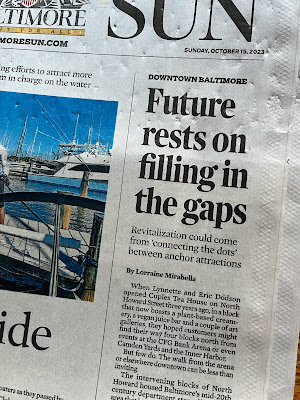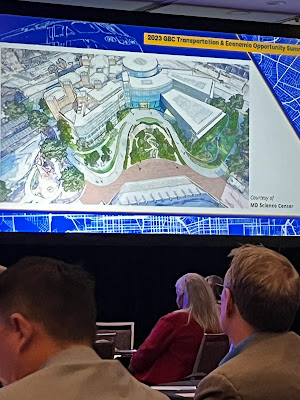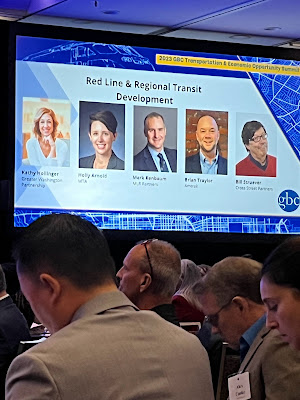"Show me a state that clicks on all cylinders and it’s largest city isn’t. For Maryland to thrive Baltimore needs to lead the charge. But the city can’t do it alone.”[...]“Stop the binary. This is not about choosing between downtown or the neighborhoods. We can do both.” (Governor Moore at the Transportation & Economic Development Summit of the Greater Baltimore Committee on Monday)
 |
| Mind the Gap warning at the London Underground (Hidden London) |
Baltimore surely isn't running on all cylinders. Instead it is a city full of gaps and many disconnected actions and projects. That Baltimore's problem isn't the lack of good stuff, heroic actions and beautiful projects but the lack of connectivity and coordination has long been a conviction of mine.
In the 1990s when we discussed the state of the "city that reads" in the Urban Design Committee of AIA which I co-chaired, I often compared Baltimore to a burn patient. Healthy skin had been grafted on to extensive burns in the hope the patches would grow together.
No lack of skin grafts, large and small: Charles Center, the Inner Harbor, Harbor East, Belvedere Square, Camden Yards, the Convention Center expansion. These operations go so far back, that some of the grafts shriveled themselves, far from being healthy islands that could spread. Some have been in the pipeline for so long that one wonder if they still have healing power, the "Superblock" and State Center come to mind. A lot more is in the pipeline as became evident at GBC's "summit".
 |
| SUN headline on Sunday (Photo: Philipsen) |
The bottom line is that dereliction, abandonment or otherwise unpleasant stretches pockmark the City in all directions interspersed by the detritus of the car friendly city that disrupts the urban fabric: parking garages on and off ramps, freeways, turn-lanes, garage driveways, services bays, hotel port cocheres, loading docks and gas stations. It really isn't surprising that Baltimore's streets so often look devoid of people while they are congested by cars.
Finally the gaps have reached the front page of the Baltimore SUN which in its Sunday print edition featured the headline: "Future rests on filling the gaps" and bemoans that "gaps riddle downtown Baltimore." The articles continues: "Like many central business districts , it also struggles with crime, the loss of businesses, jobs and foot traffic".
Then the story pivots to developer David Bramble who calls filling the gaps "connecting the dots", which, as the SUN attributes to "boosters" is critical to revitalizing downtown. "connections should exist among landmarks, from Harbor East and Harborplace to the stadium and casino district. to the Arena and the University of Maryland", the SUN quotes Bramble. "How do we connect all these things to drive investment in between them and create connectivity? You want it to feel like one connected district as opposed to pockmarked spaces".
On Monday Bramble sits on the stage of a Convention Center ballroom and moderates three representatives of the communities he met during his listening sessions about HarborPlace. He doesn't talk about his gap theory but has brought community members to the podium to share their Harborplace expectations. However, the entire GBC summit titled "transportation and economic opportunity" turned out to be an elaboration on the gap theory.
 |
| GBC Summit on Monday (Photo: Philipsen) |
Panel after panel reports about the many projects underway in Baltimore, transit oriented development (Lutherville in the County and Penn Station in the City), the Planned Red Line revival, to the plans that the Aquarium and the Science Center and the successful efforts of updating the Arena into a venue than can outperform Philadelphia. The discussion went on to the stadium upgrades and the plans to connect the Casino area north to the two stadia and east towards Sharp Leadenhall. All acknowledged that they need to work in concert, heeding Bramble's admonition that "developers must think beyond their own projects and collaborate on finding ways to connect attractions by improving pedestrian access, roadways, transit and safety".
Connections and pedestrian access, of course, concern public facilities and require the popular public-private partnership arrangements. Indeed, Bramble's Harborplace pavilions sit on public ground. Based on the principle of better access Bramble has opened the discussions to include additional city owned lands including streets such as Pratt and Light Streets and the McKeldin Plaza. Taking space from these super wide roadways potentially allows for Harborplace solutions that involve a much larger area than today's pavilions occupy.
GBC's Monday "summit" featured enough of the "dots" around the waterfront that one could see how they could connect through good collaboration. The mere fact to have the disparate voices of the Aquarium, the Science Center, the Stadium Authority, the Arena and the Downtown and the Waterfront Partnerships and the MTA all in one room was innovation progress.
 |
| David Bramble (left) hosts a panel about HarborPlace (Photo: Philipsen) |
Some 25 years ago the AIA Urban Design Committee worked on connectivity in five downtown Baltimore districts. Ideas included an attractive walking loop that would draw people away from the waterfront up to Lexington Market over to the University of Maryland and back to the Convention Center; lowering the last mile of the JFX, and connecting Penn Station by covering a small part of the ditch in which the JFX runs. Penn Station, UM and even the Lexington market since then got large capital infusions and flourish or are promising to flourish soon. However, the connectivity is still lacking, often one has to traverse entire blocks to get to the next functioning patch, something that few are will to do, especially when public safety is no longer a given.
The Mayor, the Governor and the deputy Secretary of Transportation of DOT in DC all spoke up for Baltimore. They represent the powers that can fill the gaps. They all control or influence public spaces. They proclaimed to give Baltimore a shot in the arm for better connectivity, more equity, and access. As Governor Moore said, the stars have never been better aligned. This should be "Baltimore's moment".
Klaus Philipsen, FAIA
See also my article on the non-local blog about the future of downtowns:
From Cubicles to Community: The City Beyond the Office (1of 2)
(all photos below from the GBC summit)
 |
| Planned Penn Station redevelopment (Photo: Philipsen) |
 |
| Planned floating planting island at the Aquarium Pier 5 (Photo: Philipsen) |
 |
| Planned new green learning space outside the Science Center (Photo: Philipsen) |






No comments:
Post a Comment